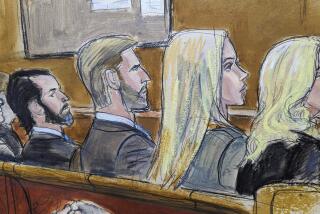TV in Courtroom Can Act as Primer on Legal System
- Share via
“Verdict,” the new CBS “reality” series on criminal trials, begins each program with the slogan: “There are no actors, no scripts and no re-enactments.” It certainly lives up to that billing. And, it definitely is not “L.A. Law,” the popular but glitzy series on the trials and tribulations of a mythical L.A. law firm.
“Verdict” uses real cases, real people and real jury verdicts (as reported in Calendar, June 20). Each program chronicles the outcome of one criminal case by mixing courtroom action with interviews of witnesses, prosecutors, defense lawyers, defendants and their accusers. Each show ends with the jury’s verdict and the defendant’s reaction.
With many courtrooms now open to cameras, “Verdict” is able to provide a far more realistic picture of what actually happens in courtrooms than do “L.A. Law,” “Perry Mason,” “Matlock” or other courtroom TV dramas. While entertaining, these shows are fiction and often misrepresent what lawyers do and how the legal system works. (An exception is “Law & Order,” which focuses on the different roles of the police and prosecutors.)
If “L.A. Law” were actually representative, then every lawyer would be wealthy, well dressed and only handling cases that make the 5 o’clock news each night. Of course, this is not true, yet that image pervades the public’s perception of lawyers.
Similarly, Perry Mason never failed to get a client off, while proving that someone else was actually the villain. That image of lawyers is equally false. Most criminal defendants are guilty, though by no means all are. Not-guilty verdicts are hardly the norm.
“Verdict” can be subjected to some similar criticism. To keep viewers interested, it does focus on trials, while in reality the overwhelming majority of criminal cases are disposed of by negotiated guilty pleas.
Nevertheless, “Verdict,” with its real cases, does show how the legal system actually operates--and this is a plus, because by accurately reflecting what goes on in a courtroom, the public becomes better informed and equipped to understand this country’s complicated legal system.
For many years, all courtrooms were closed to television, so it is not surprising that public understanding of the courts is so limited, and even sometimes just plain wrong, since it mainly has been based on fictional TV drama.
Closure was due to the sometimes circus-like coverage of cases, such as the famous 1965 case involving financier Billy Sol Estes where the Supreme Court reversed Estes’ criminal conviction, concluding that his constitutional right to a fair trial had been prejudiced by the extensive television and radio coverage his trial received.
The federal courts banned all television cameras from the courtroom, and the state courts were quick to follow. Only recently have most state courts relented (this is why the cases on “Verdict” are in state court), and the federal courts are only now experimenting with cameras in a few courtrooms.
Today, in fact, marks the beginning of a three-year experiment to determine the effects of cameras in federal courts. Also starting today is a new cable service, the Courtroom Television Network, which will cover live courtroom trials from across the country.
The Supreme Court still refuses to allow cameras to cover its own proceedings, though it did hold in 1981 that a criminal defendant has no absolute constitutional right to insist that cameras be removed from the courtroom. Instead, the facts of each case determine whether television coverage is inappropriate.
With the new television eyes now available, viewers hopefully will be able to learn about unfamiliar court concepts. However, those responsible for the now-growing television coverage of courts and “reality” courtroom programs need to make sure that laws and concepts are explained. Only then will the true value of this new courtroom coverage be fully realized.
One episode of “Verdict,” for example, notes that criminal defendants do not have to testify unless they choose to do so, but it does not explain why this is the law. Most viewers probably do not know that the Fifth Amendment provides that criminal defendants cannot be compelled to give evidence against themselves.
The technological problems with early television equipment--its cumbersome size and its need for blinding lights--have been solved. When television was new, it collided with the normal human concern about the effects of a new technology. It is time to put that Luddite-like response behind us.
Today, television is no more novel than the printing press. Reporters with pencils have free access to the courtrooms; so should reporters with cameras. A picture is often worth a thousand words.
“Verdict” and the newly opened courtroom coverage will bring those pictures into our homes, adding an important dimension to our understanding of how the judiciary--the least understood branch of our government but currently maybe the most important--works.
While it does not offer solutions to the problems our legal system faces (that it is too costly, especially when resolving minor disputes, and that it is too slow), “Verdict” does contribute to our understanding of the system. We should be thankful for that.
More to Read
The complete guide to home viewing
Get Screen Gab for everything about the TV shows and streaming movies everyone’s talking about.
You may occasionally receive promotional content from the Los Angeles Times.






